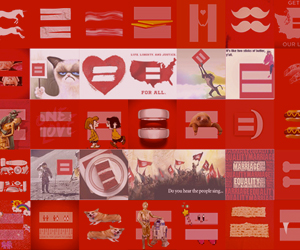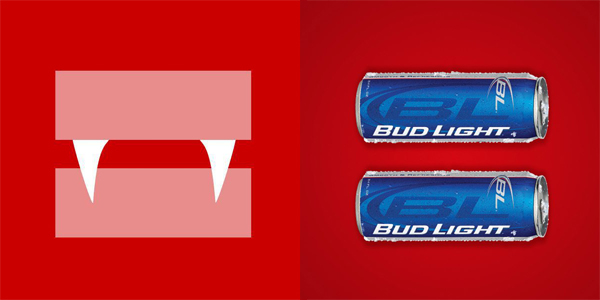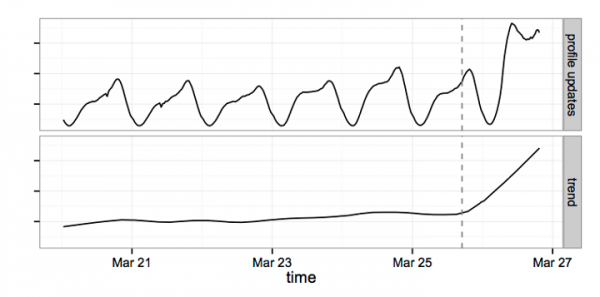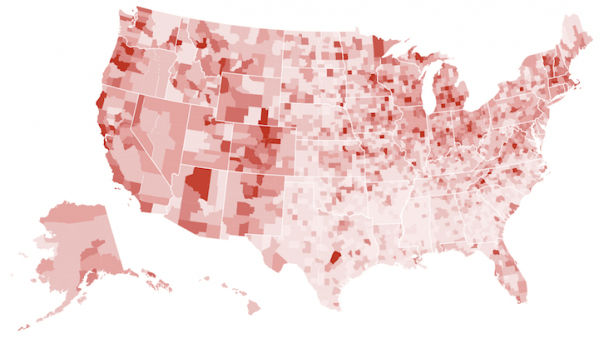 Unless you gave up Facebook for Lent, I’m sure that last week you saw a number of your Facebook friends’ profile photos (and possibly your own) change to a pink square with an equal sign in support of marriage equality.
Unless you gave up Facebook for Lent, I’m sure that last week you saw a number of your Facebook friends’ profile photos (and possibly your own) change to a pink square with an equal sign in support of marriage equality.
The grassroots movement, initiated by the Human Rights Campaign on March 25, spread virally throughout the week, filling users’ news feeds with a sea of red and pink (and other various one-offs). The campaign was timed to coincide with the oral arguments in the Supreme Court over Proposition 8, California’s gay-marriage ban, and DOMA, the Defense of Marriage Act, a law that denies federal benefits to same-sex couples.
We’re big fans of viral content here at PostAd, because more often than not it stems from having created content so funny, entertaining or useful that it had to be shared. Facebook did us a favor by investigating the campaign’s data trends, helping us all dive deeper into the HRC’s success.
So why exactly did the photo meme spread so quickly? Will this have an effect, or is it more social activism (or slacktivism)? What role did brands play, and was their participation genuine? More after the jump.
Equality by the Data
Since the intent of the campaign was to get users to update their profile photos, Facebook compared profile-photo updates on Tuesday, March 26, when the campaign went viral, to the previous Tuesday and found a 120 percent increase (roughly 2.7 million users). It also used a time-series model to show the drastic increase.
Facebook uncovered data suggesting that the vast majority of users taking part in the viral campaign were between the ages of 20 and 40, and that the highest participation was by 30-year-olds (roughly 3.5 percent of 30-year-olds updated their profile pictures). The highest participation rates by geographical location were (not surprisingly) the Northeast and Pacific parts of the United States as well as the Great Lakes region.
One interesting observation was of the high rate of participation in counties with colleges and universities. This demographic seems to be a jumping-off point for viral media—the perfect audience in that it has time to consume content and networks of friends to share it with. The first Harlem Shake video [link] is believed to have been filmed in a college dorm room.
Activism or Slacktivism?
The effectiveness of viral, cause-based efforts not rooted solely in fund-raising is often questioned. Will 2.7 million people’s changing their profile photos actually make a difference? If so, in what way? The same questions plagued Invisible Children’s Kony 2012 campaign. Many teens and millennials shared the video that exposed Joseph Kony’s atrocities, but were those low-cost efforts a substitute for more-substantive actions? The answers to those questions depend on whom you ask.
Facebook’s data science researcher Eytan Bakshy is optimistic about the campaign’s effectiveness, according to Venture Beat; he notes that “for a long time, when people stood up for a cause and weren’t all physically standing shoulder to shoulder, the size of their impact wasn’t immediately apparent. But today we can see the spread of an idea online in greater detail than ever before. That’s data well worth finding.”
Part of what’s behind the achieving of a cause’s ultimate goals, which are often lofty and long-term (curing cancer, ending poverty, capturing Kony, equal rights for all), is mass awareness, and an effective viral social-media campaign can help achieve that in a shorter time. While thirty-somethings on Facebook’s all at once updating their profile pictures may not sway the Supreme Court one way or another, it does make uninformed audiences aware that the discussion is being had, as well as of what’s at stake and of what can be done to support gay rights.
The Brand Bandwagon
With viral success comes imitation (and parody), and the equality meme was no different. Along with original user-generated remixes, countless brands threw their hats in the ring. The HRC loved the support, and all the promotion that brands added was (for the most part) good for the HRC’s awareness push.
But the issue caused a hot-button debate in the Story offices. After Bud Light posted this photo of the equality sign composed of two Bud Light cans, we began to wonder whether these branded spin-offs were in fact public support of marriage equality or just an attempt by a brand to insert itself into a popular meme.

Before Bud Light posted its spin-off, we applauded True Blood’s version of the equality photo. The addition of fangs aligned the brand with the HRC without inserting overt branding, and the show itself has an authority to publish because it has explored the topic of discrimination (as regards gay rights) in previous episodes.
Though I applaud Bud Light’s effort to take a side (one that I happen to agree with), something about the substitution of two beer cans for the equal sign didn’t feel right. Bud Light didn’t embrace the spirit of the meme, which was to use the photo as one’s profile picture. It was willing to pounce on the opportunity to embrace an already proven meme (versus those brands that embraced it early on, unsure of public reaction) but unwilling to go as far as using it for its profile photo, even though its version included Bud Light branding. Finally, it’s unclear if Bud Light has the authority to publish on the topic. Does it actually do anything to support gay rights? Bud Light does have a history of supporting the LGBT community according to Business Insider, but that hardly seems to be part of the brand’s core narrative.
Reaction to Bud Light’s version was overwhelmingly positive, according to the top comments (this could be determined thanks to Facebook’s new, threaded reply system) and the post garnered more than 11,000 shares, 55,000 Likes and 2,000 comments. So it’s fair to say that the Bud Light audience appreciated the brand’s alignment with the cause, and Bud Light’s audience is what’s most important. But it’s not an effort that can be held in the same high esteem as that of Oreo, which created its multi-tiered, rainbow-colored Oreo cookie as a stand-alone expression of equality without the comfort of knowing how audiences would react.
Billons and Billions Served
For the HRC, the effort can be seen as nothing less than a complete success, at least from the perspective of awareness. There’s no evidence that any paid media went toward promoting the campaign (though that’s unconfirmed), so the millions of people who took part in the effort provided the HRC with billons of impressions, all for little or no cost. The HRC did have a sizable audience to help ignite the campaign (more than 1,000,000 fans), but a success like this can be attributed only to the power of social media and its ability to expose audiences, particularly influencers, to content and campaigns, branded and otherwise, at a lower cost and with a greater effectiveness than can be gotten with paid media alone.
The branded and user-generated spin-offs helped fuel the HRC’s success but existed in a gray area between wholehearted support and an attempt to piggyback on what was already a proven meme. While I’m all for brands supporting gay rights (just my opinion), they have to think carefully about how they execute that support in a social space.
What do you think? Did it make sense for any/all brands to take part? Did brands need an authority to publish on this topic?




